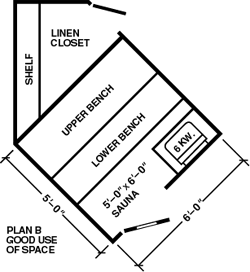Pre-Planning Hints
The Sauna should be planned for ultimate enjoyment and relaxation.
If possible, the space should be large enough for adequate seating and reclining. As a guide, allow 2' of bench space per person, for sitting purposes; it is necessary to have a 6' long bench to accommodate a reclining bather. Bench widths should be 20" for an upper bench, and about 16" for a lower bench. Do not plan a Sauna with angles (which will cut bench space and add wasted cubic footage. Two levels of benches are very important in a good Sauna-the upper bench is necessary to make use of the heat (which rises to the ceiling level). The lower bench can be used as a step up to the upper bench or as a sitting bench at the lower temperature level. For complete relaxation, a small dressing room with cooling bench or benches should be located next to the Sauna. This room might also be used as a combination cooling/exercise area.
Sauna Door
The Sauna door must open out and it should have no lock. It should be only 24" wide to prevent unnecessary loss of heat and warpage. The door should not open directly into a spa area, as chlorinated humidity will rust the hinges and warp the door. Do not put a handicapped door (36") on a Sauna unless the room is large enough to accommodate the movement of a wheelchair, with proper ramp and grab bar. (The metal wheelchair will get hot and will be uncomfortable for the operator. An attendant is necessary when a Sauna is intended for handicapped usage.)
The Importance of a Shower
As a Sauna is a deep cleansing bath which opens pores and flushes out the body's impurities, it is necessary to use soap and water in a shower to rinse off this waste. For convenience, a shower should be located near the Sauna. However, do not put a shower head in the actual Sauna room as the humidity from the shower can harm the electric components in the Sauna heater. If a Sauna is located close to a pool or spa, a dressing room should be designed between the two areas to keep harmful chlorine vapors and humidity from damaging electrical and metal parts in the Sauna heater.
Ventilation
Venting is not required for any safety reasons but it does make the Sauna atmosphere more comfortable. We always supply vents for all of our Sauna packages. A vent is really just a hole in the wall leading from the Sauna to some other adjoining room in the house. It's best to have a lower (intake) vent and an upper (exhaust) vent in a Sauna to provide for good air circulation. The lower vent brings air in for a comfortable atmosphere, and the upper vent dispels used air. The lower vent should be placed about 4" from the floor, close to the Sauna heater if possible, to allow cooler air to flow through the heater and enable it to function better. The upper vent can be anywhere; it can be as low as 24" from the floor but usually it is placed about 6" from the ceiling level. Do not place the upper vent directly above the Sauna heater. Ductwork for the vents is not necessary. The Sauna usually vents to air from inside the house. You may vent to outside air if you desire, but heat up time may take a little longer due to the draw of cooler outside air. When both vents are open, air changes 4 to 6 times per hour. For faster heating, the upper vent should be closed when the Sauna is heating. The rough opening size for our standard vents is 4” x 10”.
Ceiling Height Should Be 7' To Allow Enough Heat at Bench and Head Levels
It's important to reduce Sauna room height from a standard ceiling height of 8' to the Sauna norm of 7' from the finished floor. (Sauna ceiling can also be as low as 6' 2".) An 8' ceiling wastes heat, energy and building material; and it increases the heating time. The diagram below shows the variance of temperature at various levels in the Sauna room.
Sauna Temperature Comparisons
The importance of lowering the Sauna ceiling from 8' to 7' is shown in the following temperature comparison chart: Notice that the Sauna room temperature is 20 degrees cooler at the upper bench level and at the bather's head level in the Sauna with the improper ceiling height of 8'. As the heat rises from floor to ceiling, there is too much wasted heat at the upper ceiling level and not enough heat at the bench levels where the bathers sit or lie.
Correct Use of Space
Below is an example of the importance of pre-planning when designing a Sauna. Plan A and B have exact shape and size. Plan A uses the entire space as a Sauna, resulting in benches with little seating space and no reclining area. There is too much walking area-with a waste of space, building material and efficiency. Plan B creates 2 useable rooms from the same space, allows a Sauna with a more comfortable bench area, and leaves necessary walking space. The linen closet is a bonus.
 |
 |
Contact Country Saunas with any other questions or comments you may have about any of our products or adding a sauna to your home.

